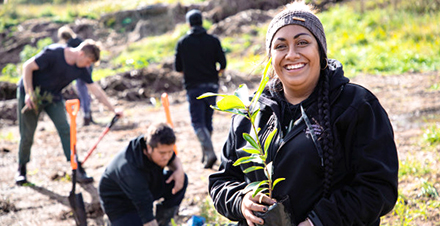Working under the spectre of Kauri disease, Northland iwi Te Roroa is acutely aware of the need for strict biosecurity rules to protect its ambitious ecological restoration project. This makes winning the Ministry for Primary Industries (MPI) 2021 New Zealand Biosecurity Awards ‘Māori Award’, announced recently, all the more rewarding says Freda Walker, manager of Te Roroa’s Te Toa Whenua Nursery. Source: Timberbiz
“Āe, we are very humbled to have received the MPI 2021 Biosecurity Māori Award and are honoured to have been given the opportunity to share our story and the highlights of our mahi within the environmental space,” Ms Walker said.
Te Toa Whenua Nursery is a project funded through the One Billion Trees program, providing financial support for staff over three years to oversee the establishment and operation of a nursery with a capacity of 100,000 native seedlings per annum. One Billion Trees funding for the project is due to finish in August 2023.
The nursery is a critical component of Te Toa Whenua, an initiative for the ecological restoration of land returned to Te Roroa as part of the Treaty of Waitangi settlement process. It aims to restore 900 hectares in the Waipoua Valley – bordering the iconic Waipoua Kauri Forest – from exotic forestry to a mosaic of sustainable land uses.
“The project represents an opportunity for Te Roroa, partners, and the community to actively exercise tangata whenuatanga, by providing contexts for learning where the language, identity and culture of Māori learners and their whānau is affirmed,” said Alex Wilson, director forest development, grants and partnerships at Te Uru Rākau – New Zealand Forest Service.
Ms Walker says to be involved in the project is “hugely rewarding”, but not without significant challenges. Top of mind is the sobering reality they are located at ‘ground zero’ of Kauri disease, caused by a pathogen called Phytophthora agathidicida.
Tāne Mahuta, the world’s largest known kauri tree and over 2000 years old, is only 20km away.
“Mana whenua consider these ancient trees our tīpuna. To know that our ancestors are in serious danger is traumatising for us,” Ms Walker said. “Biosecurity is top of mind in all of the work that we do, not only in our nursery waahi (space) but all over the whenua.
“We have created and implemented biosecurity policies and protocols to help protect our Ngahere by making sure that we are doing everything that we can to not be vectors of the spread of any pathogens. We work collaboratively alongside the scientific community groups and are at the forefront for any new developments so that we can make the appropriate changes when and if needed.
“The restoration and environmental health of our whenua and Ngahere is of utmost importance to Te Toa Whenua of what we do today, so that our future generations will continue this mahi into fruition.”
In addition to the nursery, Te Toa Whenua operates an extensive pest control and weed eradication programme. The predator control network is more than 32km long with over 700 bait stations covering parts of Waipoua Forest.






